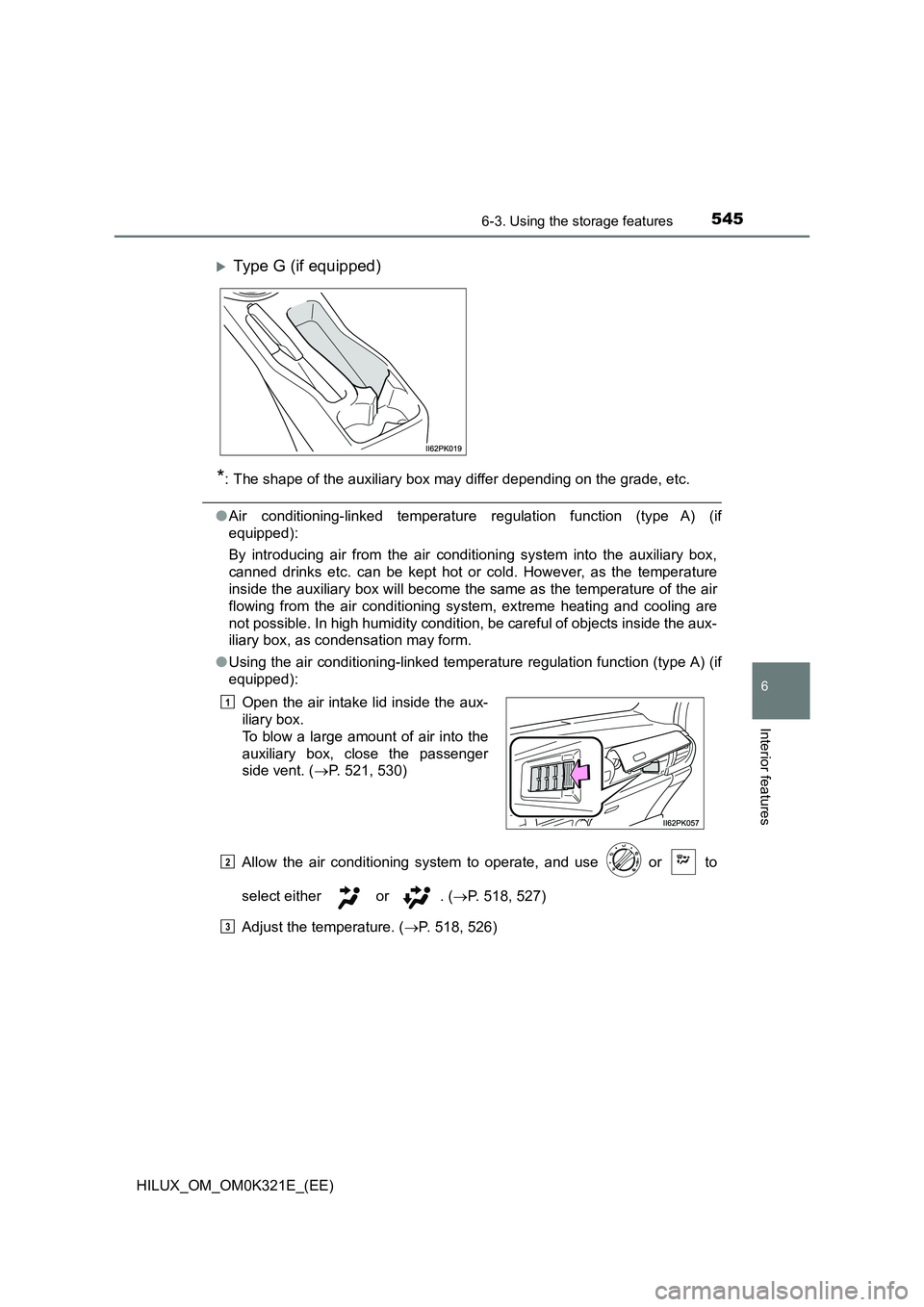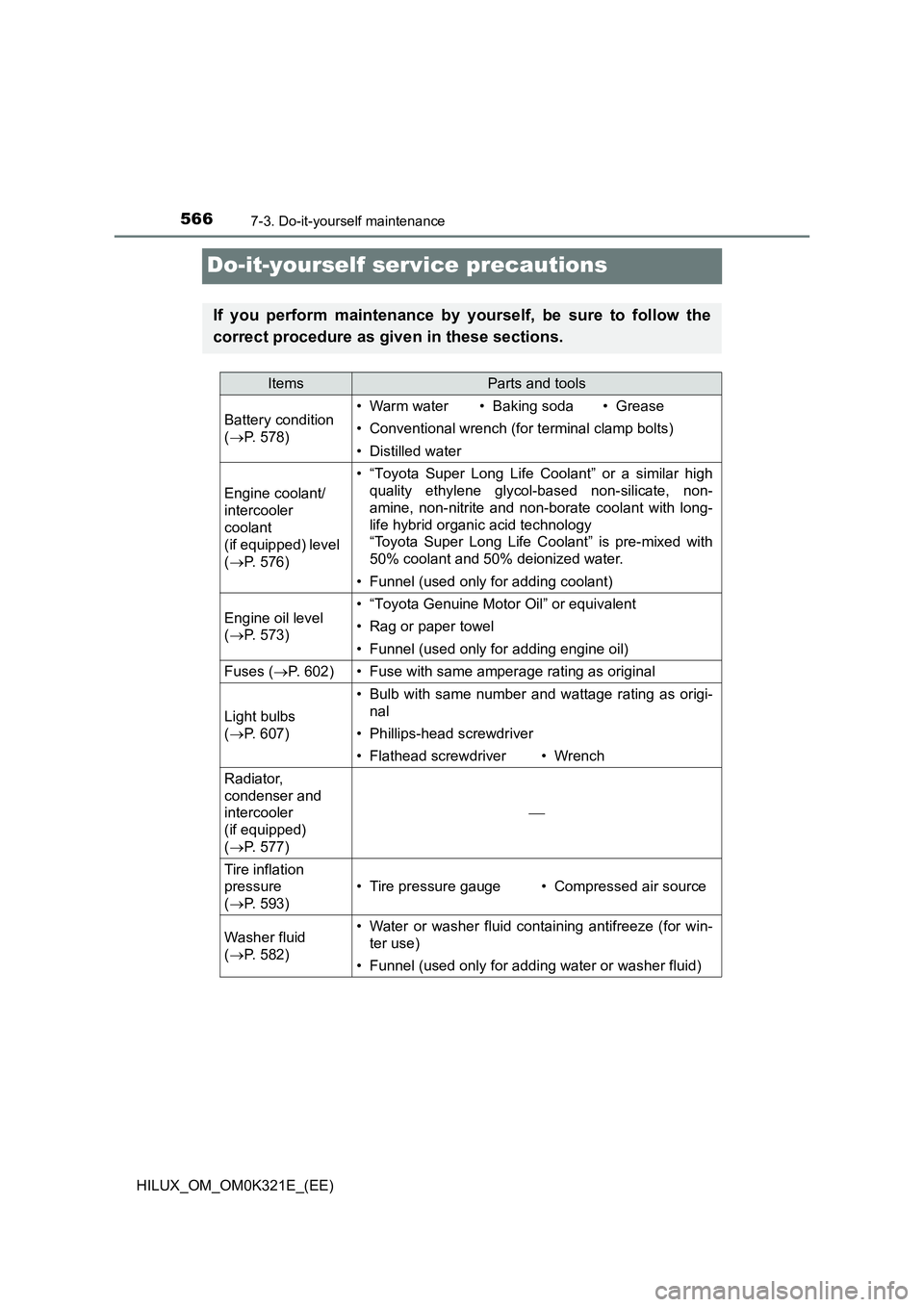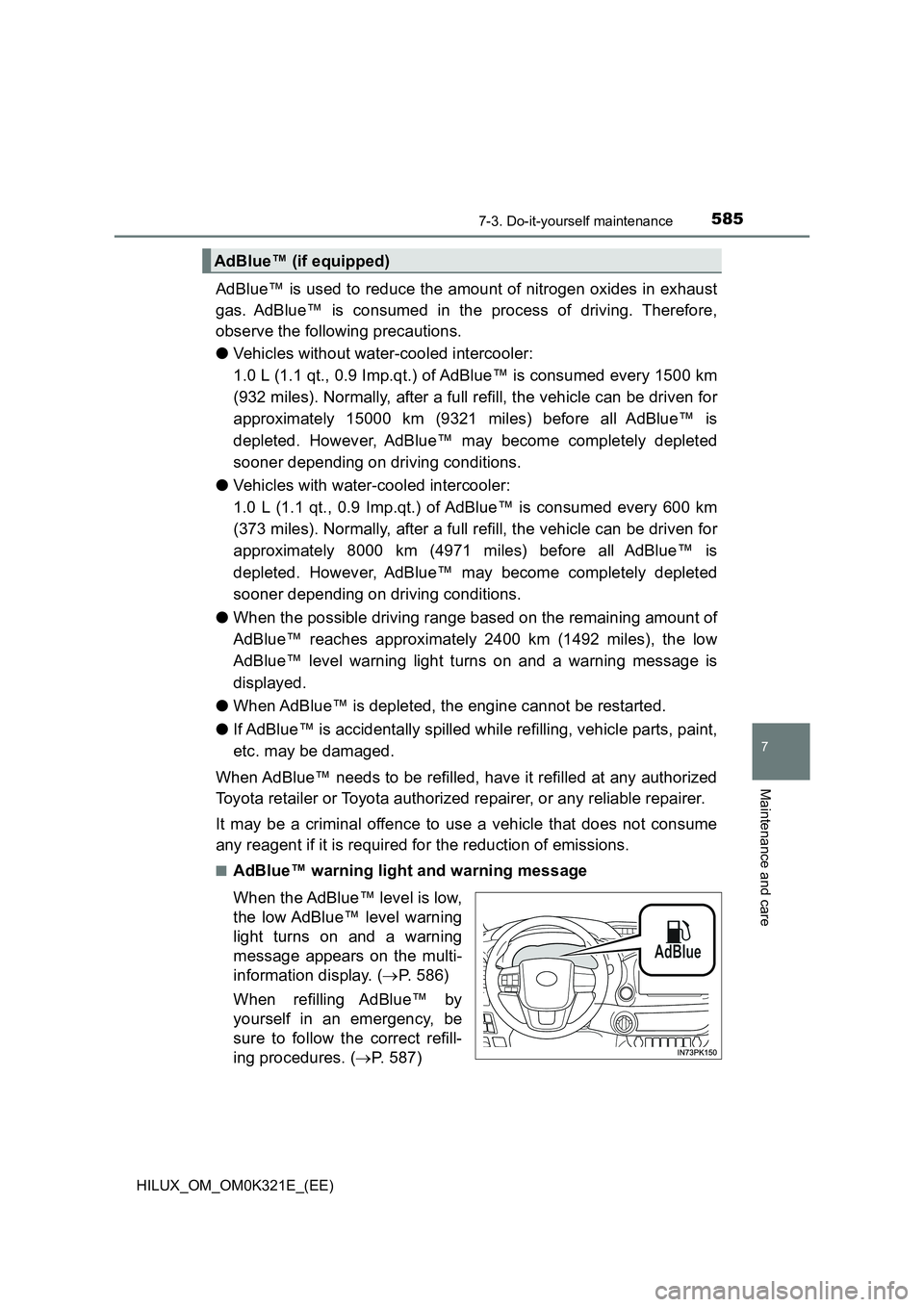Page 545 of 744

5456-3. Using the storage features
HILUX_OM_OM0K321E_(EE)
6
Interior features
*: The shape of the auxiliary box may differ depending on the grade, etc.
●Air conditioning-linked temperature regulation function (type A) (if
equipped):
By introducing air from the air conditioning system into the auxiliary box,
canned drinks etc. can be kept hot or cold. However, as the temperature
inside the auxiliary box will become the same as the temperature of the air
flowing from the air conditioning sy stem, extreme heating and cooling are
not possible. In high humidity condition, be careful of objects inside the aux-
iliary box, as condensation may form.
● Using the air conditioning-linked temperature regulation function (type A) (if
equipped):
Allow the air conditioning system to operate, and use or to
select either or . ( P. 518, 527)
Adjust the temperature. ( P. 518, 526)
Type G (if equipped)
Open the air intake lid inside the aux-
iliary box.
To blow a large amount of air into the
auxiliary box, close the passenger
side vent. ( P. 521, 530)
1
2
3
Page 555 of 744
555
7Maintenance and care
HILUX_OM_OM0K321E_(EE)
7-1. Maintenance and care
Cleaning and protecting
the vehicle exterior .......... 556
Cleaning and protecting
the vehicle interior ........... 560
7-2. Maintenance
Maintenance
requirements.................... 563
7-3. Do-it-yourself maintenance
Do-it-yourself service
precautions ...................... 566
Hood .................................. 568
Engine compartment.......... 570
Tires ................................... 590
Tire inflation pressure ........ 593
Wheels ............................... 595
Air conditioning filter .......... 597
Wireless remote control/
electronic key battery....... 599
Checking and
replacing fuses ................ 602
Light bulbs ......................... 607
Page 559 of 744
5597-1. Maintenance and care
7
Maintenance and care
HILUX_OM_OM0K321E_(EE)
NOTICE
■When using a high pressure car wash
● Do not bring the nozzle tip close to boots (rubber or resin manufactured
cover), connectors or the following parts. The parts may be damaged if
they come into contact with high-pressure water.
• Traction related parts
• Steering parts
• Suspension parts
• Brake parts
● Keep the cleaning nozzle at least 30 cm (11.9 in.) away from the vehicle
body. Otherwise resin section, such as moldings and bumpers, may be
deformed and damaged. Also, do not continuously hold the nozzle in the
same place.
● Do not spray the lower part of the windshield continuously.
If water enters the air conditioning system intake located near the lower
part of the windshield, the air conditioning system may not operate cor-
rectly.
Page 564 of 744

5647-2. Maintenance
HILUX_OM_OM0K321E_(EE)
■Where to go for maintenance service?
In order to maintain your vehicle in the best possible condition, Toyota recom-
mends that maintenance service operations as well as other inspections and
repairs be carried out by authorized Toyota retailers or Toyota authorized
repairers, or any reliable repairers. For repairs and services covered by your
warranty, please visit an authorized Toyota retailer or repairer, who will use
genuine Toyota parts in repairing any difficulties you may encounter. There
can also be advantages in utilizing authorized Toyota retailers or repairers for
non-warranty repairs and services, as members of the Toyota network will be
able to expertly assist you with any difficulties you may encounter.
Your Toyota retailer or Toyota authoriz ed repairer, or any reliable repairer will
perform all of the scheduled maintenance on your vehicle reliably and eco-
nomically due to their experience with Toyota vehicles.
■ Does your vehicle need repairs?
Be on the alert for changes in performance and sounds, and visual tip-offs
that indicate service is needed. Some important clues are:
● Engine missing, stumbling or pinging
● Appreciable loss of power
● Strange engine noises
● A fluid leak under the vehicle (However, water dripping from the air condi-
tioning system after use is normal.)
● Change in exhaust sound (This may indicate a dangerous carbon monoxide
leak. Drive with the windows open and have the exhaust system checked
immediately.)
● Flat-looking tires, excessive tire squeal when cornering, uneven tire wear
● Vehicle pulls to one side when driven straight on a level road
● Strange noises related to suspension movement
● Loss of brake effectiveness, spongy feeling brake pedal or clutch pedal,
pedal almost touches the floor, vehicle pulls to one side when braking
● Engine coolant temperature continually higher than normal
If you notice any of these clues, take your vehicle to any authorized Toyota
retailer or Toyota authorized repairer, or any reliable repairer as soon as pos-
sible. Your vehicle may need adjustment or repair.
Page 566 of 744

5667-3. Do-it-yourself maintenance
HILUX_OM_OM0K321E_(EE)
Do-it-yourself service precautions
If you perform maintenance by yourself, be sure to follow the
correct procedure as given in these sections.
ItemsParts and tools
Battery condition
( P. 578)
•Warm water• Baking soda•Grease
• Conventional wrench (for terminal clamp bolts)
• Distilled water
Engine coolant/
intercooler
coolant
(if equipped) level
( P. 576)
• “Toyota Super Long Life Coolant” or a similar high
quality ethylene glycol-based non-silicate, non-
amine, non-nitrite and non-borate coolant with long-
life hybrid organic acid technology
“Toyota Super Long Life Coolant” is pre-mixed with
50% coolant and 50% deionized water.
• Funnel (used only for adding coolant)
Engine oil level
( P. 573)
• “Toyota Genuine Motor Oil” or equivalent
• Rag or paper towel
• Funnel (used only for adding engine oil)
Fuses (P. 6 0 2 )• Fuse with same amperage rating as original
Light bulbs
( P. 607)
• Bulb with same number and wattage rating as origi-
nal
• Phillips-head screwdriver
• Flathead screwdriver•Wrench
Radiator,
condenser and
intercooler
(if equipped)
( P. 577)
Tire inflation
pressure
( P. 593)
• Tire pressure gauge• Compressed air source
Washer fluid
( P. 582)
• Water or washer fluid containing antifreeze (for win-
ter use)
• Funnel (used only for adding water or washer fluid)
Page 577 of 744

5777-3. Do-it-yourself maintenance
HILUX_OM_OM0K321E_(EE)
7
Maintenance and care
■If the coolant level drops within a short time of replenishing
Visually check the radiator, hoses, engine coolant reservoir cap, intercooler
coolant reservoir cap (if equipped), drain cock and water pump. If you cannot
find a leak, have any authorized Toyota retailer or Toyota authorized repairer,
or any reliable repairer test the cap and check for leaks in the cooling system.
Check the radiator, condenser and Intercooler coolant radiator/inter-
cooler and clear away any foreign objects. If any of the above parts is
extremely dirty or you are not sure of their condition, have your vehi-
cle inspected by any authorized Toyota retailer or Toyota authorized
repairer, or any reliable repairer.
WARNING
■ When the engine is hot
Do not remove the radiator cap (if equipped), the engine coolant reservoir
cap or intercooler coolant reservoir cap (if equipped).
The cooling system may be under pressure and may spray hot coolant if the
cap is removed, causing serious injuries, such as burns.
NOTICE
■ When adding coolant
Coolant is neither plain water nor straight antifreeze. The correct mixture of
water and antifreeze must be used to provide proper lubrication, corrosion
protection and cooling. Be sure to read the antifreeze or coolant label.
■ If you spill coolant
Be sure to wash it off with water to prevent it from damaging parts or paint.
■ Notice on coolant quality
Do not use improper coolant. If improper coolant is used, the engine cooling
system may be damaged.
Radiator, condenser and Intercooler coolant radiator/intercooler
(if equipped)
WARNING
■ When the engine is hot
Do not touch the radiator, condenser or Intercooler coolant radiator/inter-
cooler as they may be hot and cause serious injuries, such as burns.
Page 585 of 744

5857-3. Do-it-yourself maintenance
HILUX_OM_OM0K321E_(EE)
7
Maintenance and care
AdBlue™ is used to reduce the amount of nitrogen oxides in exhaust
gas. AdBlue™ is consumed in the process of driving. Therefore,
observe the following precautions.
● Vehicles without water-cooled intercooler:
1.0 L (1.1 qt., 0.9 Imp.qt.) of AdBlue™ is consumed every 1500 km
(932 miles). Normally, after a full refill, the vehicle can be driven for
approximately 15000 km (9321 miles) before all AdBlue™ is
depleted. However, AdBlue™ may become completely depleted
sooner depending on driving conditions.
● Vehicles with water-cooled intercooler:
1.0 L (1.1 qt., 0.9 Imp.qt.) of AdBlue™ is consumed every 600 km
(373 miles). Normally, after a full refill, the vehicle can be driven for
approximately 8000 km (4971 miles) before all AdBlue™ is
depleted. However, AdBlue™ may become completely depleted
sooner depending on driving conditions.
● When the possible driving range based on the remaining amount of
AdBlue™ reaches approximately 2400 km (1492 miles), the low
AdBlue™ level warning light turns on and a warning message is
displayed.
● When AdBlue™ is depleted, the engine cannot be restarted.
● If AdBlue™ is accidentally spilled while refilling, vehicle parts, paint,
etc. may be damaged.
When AdBlue™ needs to be refilled, have it refilled at any authorized
Toyota retailer or Toyota authorized repairer, or any reliable repairer.
It may be a criminal offence to use a vehicle that does not consume
any reagent if it is required for the reduction of emissions.
■AdBlue™ warning light and warning message
When the AdBlue™ level is low,
the low AdBlue™ level warning
light turns on and a warning
message appears on the multi-
information display. ( P. 586)
When refilling AdBlue™ by
yourself in an emergency, be
sure to follow the correct refill-
ing procedures. ( P. 587)
AdBlue™ (if equipped)
Page 594 of 744
5947-3. Do-it-yourself maintenance
HILUX_OM_OM0K321E_(EE)
WARNING
■Proper inflation is critical to save tire performance
Keep your tires properly inflated.
If the tires are not properly inflated, the following conditions may occur
which could lead to an accident resulting in death or serious injury:
● Excessive wear
● Uneven wear
● Poor handling
● Possibility of blowouts resulting from overheated tires
● Air leaking from between tire and wheel
● Wheel deformation and/or tire damage
● Greater possibility of tire damage while driving (due to road hazards,
expansion joints, sharp edges in the road, etc.)
NOTICE
■ When inspecting and adjusting tire inflation pressure
Be sure to put the tire valve caps back on.
If a valve cap is not installed, dirt or moisture may get into the valve and
cause an air leak, resulting in decreased tire inflation pressure.